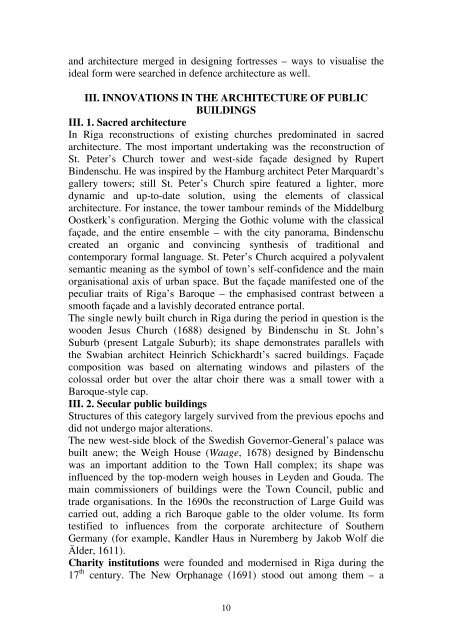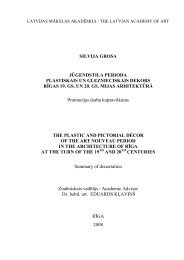Institute of Art History of the Latvian Academy of Art Anna Ancāne ...
Institute of Art History of the Latvian Academy of Art Anna Ancāne ...
Institute of Art History of the Latvian Academy of Art Anna Ancāne ...
Create successful ePaper yourself
Turn your PDF publications into a flip-book with our unique Google optimized e-Paper software.
and architecture merged in designing fortresses – ways to visualise <strong>the</strong><br />
ideal form were searched in defence architecture as well.<br />
III. INNOVATIONS IN THE ARCHITECTURE OF PUBLIC<br />
BUILDINGS<br />
III. 1. Sacred architecture<br />
In Riga reconstructions <strong>of</strong> existing churches predominated in sacred<br />
architecture. The most important undertaking was <strong>the</strong> reconstruction <strong>of</strong><br />
St. Peter’s Church tower and west-side façade designed by Rupert<br />
Bindenschu. He was inspired by <strong>the</strong> Hamburg architect Peter Marquardt’s<br />
gallery towers; still St. Peter’s Church spire featured a lighter, more<br />
dynamic and up-to-date solution, using <strong>the</strong> elements <strong>of</strong> classical<br />
architecture. For instance, <strong>the</strong> tower tambour reminds <strong>of</strong> <strong>the</strong> Middelburg<br />
Oostkerk’s configuration. Merging <strong>the</strong> Gothic volume with <strong>the</strong> classical<br />
façade, and <strong>the</strong> entire ensemble – with <strong>the</strong> city panorama, Bindenschu<br />
created an organic and convincing syn<strong>the</strong>sis <strong>of</strong> traditional and<br />
contemporary formal language. St. Peter’s Church acquired a polyvalent<br />
semantic meaning as <strong>the</strong> symbol <strong>of</strong> town’s self-confidence and <strong>the</strong> main<br />
organisational axis <strong>of</strong> urban space. But <strong>the</strong> façade manifested one <strong>of</strong> <strong>the</strong><br />
peculiar traits <strong>of</strong> Riga’s Baroque – <strong>the</strong> emphasised contrast between a<br />
smooth façade and a lavishly decorated entrance portal.<br />
The single newly built church in Riga during <strong>the</strong> period in question is <strong>the</strong><br />
wooden Jesus Church (1688) designed by Bindenschu in St. John’s<br />
Suburb (present Latgale Suburb); its shape demonstrates parallels with<br />
<strong>the</strong> Swabian architect Heinrich Schickhardt’s sacred buildings. Façade<br />
composition was based on alternating windows and pilasters <strong>of</strong> <strong>the</strong><br />
colossal order but over <strong>the</strong> altar choir <strong>the</strong>re was a small tower with a<br />
Baroque-style cap.<br />
III. 2. Secular public buildings<br />
Structures <strong>of</strong> this category largely survived from <strong>the</strong> previous epochs and<br />
did not undergo major alterations.<br />
The new west-side block <strong>of</strong> <strong>the</strong> Swedish Governor-General’s palace was<br />
built anew; <strong>the</strong> Weigh House (Waage, 1678) designed by Bindenschu<br />
was an important addition to <strong>the</strong> Town Hall complex; its shape was<br />
influenced by <strong>the</strong> top-modern weigh houses in Leyden and Gouda. The<br />
main commissioners <strong>of</strong> buildings were <strong>the</strong> Town Council, public and<br />
trade organisations. In <strong>the</strong> 1690s <strong>the</strong> reconstruction <strong>of</strong> Large Guild was<br />
carried out, adding a rich Baroque gable to <strong>the</strong> older volume. Its form<br />
testified to influences from <strong>the</strong> corporate architecture <strong>of</strong> Sou<strong>the</strong>rn<br />
Germany (for example, Kandler Haus in Nuremberg by Jakob Wolf die<br />
Älder, 1611).<br />
Charity institutions were founded and modernised in Riga during <strong>the</strong><br />
17 th century. The New Orphanage (1691) stood out among <strong>the</strong>m – a<br />
10












